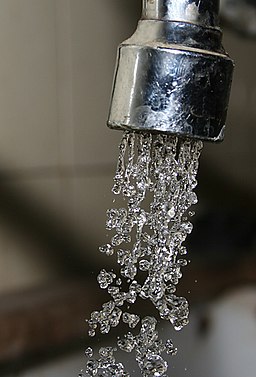Conversations around the Water Table with Project Blue Thumb (Part Two)
New water paradigms
By Amy Spark and Josée Méthot
This post is part two of a six-part interview series conducted and written by Project Blue Thumb.
Project Blue Thumb is a multi-stakeholder social lab co-convened by the Red Deer River Watershed Alliance and Alberta Ecotrust Foundation that takes a whole system approach to protecting water quality in the Red Deer River watershed. Building on the work of our current members, the PBT organizing team reached out to 13 multi-sector practitioners to hear their thoughts about the future of water in Alberta and potential directions. This post provides a snapshot from a few of our interviews relating to reimagining water and the paradigms that guide us.
“Culture is like gravity: you do not experience it until you jump six feet into the air” – Trompenaars and Hampden-Turner
Conversations often veer off into unexpected and rewarding places. The latest round of Project Blue Thumb interviews found our team grappling with the fundamental patterns of thought that guide our water systems and management. These paradigms operate imperceptibly in the background of our day-to-day lives, guiding our thinking about how something should be done, made, or even thought about.
Here we present a few highlights from these interviews, with each person hinting or overtly calling for a type of paradigm shift. Dr. Nick Ashbolt is a municipal water researcher and professor at the University of Alberta School of Public Health. He is also working on an innovative Resource Recovery Centre northwest of Edmonton focusing on the next generation of community water services.
Shannon Frank is the Executive Director of the Oldman Watershed Council, currently working on a campaign to effectively engage recreationists in restoration projects in southern Alberta headwaters.
Conversations around the Water Table with Project Blue Thumb (Part One)
Water and headwaters as cultural identity
By Amy Spark
Welcome to our inaugural post for Conversations around the Water Table, a six-part interview series led by the Project Blue Thumb Lab.
Project Blue Thumb is a multi-stakeholder social lab co-convened by the Red Deer River Watershed Alliance and Alberta Ecotrust Foundation that takes a whole system approach to protecting water quality in the Red Deer River watershed. Building on the work of our current members, the PBT organizing team reached out to 13 multi-sector practitioners to hear their thoughts about the future of water in Alberta and potential directions. This post provides a snapshot from a few of our interviews relating to water and cultural identity.
Our identity is often defined by a photograph or official document. We are known by our drivers’ licenses, passports, birthdays, eye colour, or height. We’re identified by our fingerprints, our retinas, and our social media profile. We’re acknowledged as non-robots by Captcha tests on websites. But how does water relate to our identity? Specifically, our cultural identity? What does it mean to be ‘Albertan’, while still recognizing our inherent diversity?
How urban resiliency is a triple bottom line winner for Alberta
By Laura Corbeil, Steve Herman and Alexander J.B. Zehnder
All over the world, people are asking questions about climate change. When will it affect us, how will it change our everyday activities, and what can we do about it? How do we prepare for the economic, social and environmental (triple bottom line) risks and opportunities?
These questions have complex responses that vary between communities and continents, but with the conversation started people are already creating answers for Alberta.
The reality is climate change is already underway; in Alberta, we have witnessed increasingly warmer temperatures, a trend that is predicted to continue and even intensify. It is expected climate change will produce more heat waves, floods and droughts as well as earlier snowmelt and the disappearance of glaciers.
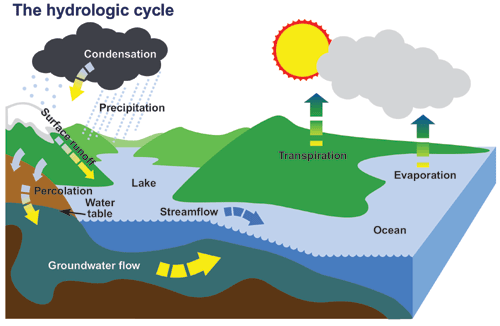 |
|
Figure 1: The hydrologic cycle. Temperature driven transpiration, evaporation and melting will increase with higher ambient temperatures, influencing the entire cycle. Source: Environment and Climate Change Canada |
It is no coincidence all of these impacts are connected to water, as climate change has pronounced effects on global, regional, and local water systems. These systems directly influence our way of life because they control water flow, availability, and quality.
Water is critical to our lives. We drink it, use it to grow our food, play in it and so much more. We are also impacted by water’s natural cycle (Figure 1) for instance the timing of precipitation and impacts on crops. Higher temperatures are predicted to impact the hydrologic cycle in many other ways, including:
- Water quality,
- Climate variability,
- Extreme weather condition frequency and/or severity, and
- Earlier snowpack melt.
All these impacts increase risks relating to water quality, quantity, and reliability; a direct result of the interconnectedness of the hydrological cycle. As we become more familiar with the possible impacts of changes to the hydrologic cycle, the question becomes: are we ready for them as best we can be?
Wastewater as a resource: it’s practically gold
By Brie Nelson
This World Water Day, let’s admit the term ‘wastewater’ is a bit of a misnomer for at least two reasons: first, wastewater can contain real gold and second, it plays a valuable role in our lives.
When it comes to municipal wastewater, in addition to the natural amounts of metals found in water, metals come from a variety of sources including clothing with odor-deterrent metal microfibers, cosmetics and pharmaceuticals. Industrial processes also use water for operations including manufacturing, extraction and cooling, which, among other activities, can result in the transportation of metal particles in wastewater.
It is fascinating to note that a wastewater treatment plant in Nagano Japan has adapted processing to extract gold from waste sludge. The plant recovers over 1 kg (2.2 lbs) of gold from 1 metric ton of ash produced by incinerating dried sludge. The region this treatment plant serves has a particularly high mineral content in the water and hosts a large number of metal manufacturing facilities and mines, including a gold mine, which results in the particularly rich wastewater.
Green Infrastructure: Why implement it in Alberta?
By Denise Di Santo
Traditionally, stormwater has been regarded as a wastewater product – conveyed off land to receiving waters through grey infrastructure via pipes, pumps and ponds. The approach is not serving us well, nor is this sustainable for ecosystems that rely on healthy, integrative systems to exist. This is because in the context of the built urban system, we are creating evermore-impervious surfaces that serve to further degrade water quality and watershed function.
Stormwater management is evolving as a more holistic undertaking, where stormwater is being treated, literally, as a vital component of water resources and our natural resource base.
Low Impact Development (LID) is an innovative stormwater management approach that follows a basic principle modeled after nature: manage rainfall and snowmelt where it meets with land, allowing it to be intercepted, infiltrated, and treated before it is introduced to receiving waters. These processes also provide flow control, and work to balance water quantity as water cycles through the system. The idea is to mimic natural processes and maintain or restore hydrologic function through the use of retained landscape features, and integrating green infrastructure, which includes raingardens, green roofs, permeable pavement, and biofiltration facilities. These are regarded as LID best management practices and are sometimes referred to as green stormwater infrastructure (GSI).
Working in tandem with grey infrastructure, green infrastructure decentralizes and supplements the treatment train, resulting in improved stormwater quality and reduced runoff throughout the drainage area. These enhancements in the stormwater management system are key to creating resilience at the site, catchment and watershed scales.
Although considered innovative, LID is not a new concept. As an example, I encourage you to explore Ian McHarg’s book, Design with Nature, first published in 1969. To conceptualize human impositions on natural environments and the need to reverse our impacts, McHarg, who had a central role in the development of environmental planning, is quoted: “Let us green the earth, restore the earth, heal the earth….”
In a sense, LID is part of the landscape architect paradigm integrating natural features and function with built form.
 |
|
Vegetated strips in parking area for interception, infiltration and treatment (note cuts for inflow). Image: University of Nevada Cooperative Extension |
Throughout North America, the shift back to nature-based solutions is becoming more commonplace. Although regulatory requirements associate the use of green infrastructure with water quality improvement and flow control, a long list of benefits are also realized.
These benefits are identified through life cycle benefit-cost analyses and include:
- improved air quality and reduced ambient temperatures
- landscape aesthetics and increased property values
- reduced stream erosion in receiving waters
- aquatic ecosystem health for fish and other species
- mental well-being and physical health, and
- providing critical terrestrial habitat.
In addition, natural and green infrastructure accrue value over time, whereas built grey infrastructure depreciates in value and requires costly lifecycle operations and maintenance and, ultimately, decommissioning.
Philadelphia, Chicago, Seattle, Vancouver and Toronto are among the leaders in establishing green infrastructure programs. In many cases, cost effectiveness and efficiency has been greater than anticipated. Programs and public-private partnerships exist to fund stormwater infrastructure retrofits, including integration of green infrastructure in the built environment, new and redeveloping. The positive return on investment has been well documented for more than a decade and it is time to take note. That said, implementation of stormwater best management practices continues to provide lessons for improvement.
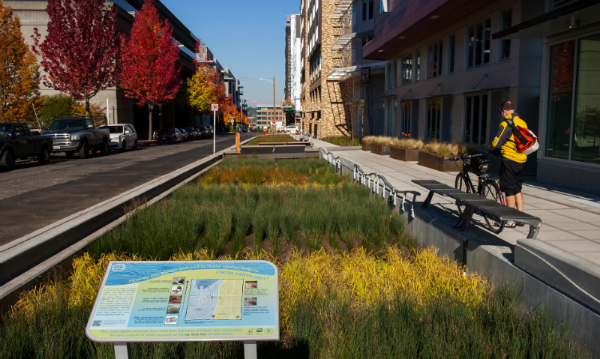 |
| My favorite “Swale on Yale” project in Seattle aka “Capital Hill Water Quality Improvement Project” (pictured Fall 2014). Image: KPG Interdisciplinary Design |
In Alberta, and in some North American cities, innovation in stormwater management practices is largely being approached with caution by policymakers. The Alberta Low Impact Development Partnership (ALIDP), a non-profit organization, has been at the forefront of the needed engagement and training of multi-disciplinary stormwater practitioners.
A shift in thinking is required to ensure the adoption of green infrastructure and supportive policy; traditional engineer and land planning disciplines tend to look for predictable, quantifiable outcomes with cookie cutter approaches in the process of developing the land base. These certainties don’t come easy with designs that yield results not immediately assessed with numbers.
Green infrastructure technologies also need to be adapted to local conditions and soils. Local research has been limited but efforts are underway to identify the best suited technologies for Alberta. As one innovative stormwater practitioner in Seattle puts it: the approach is of: “right site, right team, right design.” The choice of LID best management practices must be suited to sites, using multidisciplinary teams, including water resource planners, landscape architects, urban designers, and engineers. To add to the challenge of thinking outside the box, water resources management requires a precautionary approach—stepping into the future of risk management, particularly in the context of climate adaptation, is no longer optional.
 |
| Rain garden – by Rogersoh (Own work) [CC BY-SA 3.0 (http://creativecommons.org/licenses/by-sa/3.0)] via Wikimedia Commons |
Stormwater management innovation cannot come soon enough for places like Alberta. Uncertainties and constraints of limited water supply, and associated risks with flood and drought, are now a universal driver for building adaptation capacity and watershed resilience. Consider life cycle return on investment and trade-offs of our actions.
Water reuse has become part of this equation, to ensure water quality is matched to use while at the same time, providing a form of source control at the site scale. We can no longer afford to contaminate and convey stormwater, a critical component of water supply, to ground and surface waters. Cities and counties would do well to designate and protect natural infrastructure such as wetlands that provide ecosystem services to benefit ecosystems, rather than adopting policies and practices that for the most part, remove these assets from the landscape.
It is time to also invest in stormwater best practices research, learn from other places, and monitor and adaptively manage green infrastructure, as has been done with any innovation ever adopted successfully.
Denise is a watershed planner with a passion for connecting water and people through collaboration and inclusive planning for nature-based solutions. With broad water resources management experience, Denise takes a systems approach to innovative stormwater management, ecosystem protection and recovery, and creating conditions for resilient communities.
Further reading
Links from Denise for further reading on green infrastructure include:
Washington State University’s LID Research Program
Return on Investment – US EPA
Return on Investment – North Carolina State University
Return on Investment – ECO Northwest
Credit Valley Conservation Authority (Ontario) LID monitoring
How bacteria cultured in Alberta are helping treat algae and wastewater
By Joshua Day Chief
We’ve all seen it—excessive nutrient loading making lakes and ponds look and smell horrible. But, did you know these bodies of water typically have low dissolved oxygen, excessive algae blooms, unpleasant odours, plant growth, and stressful conditions for fish and wildlife?
Lakes and ponds stressed by unnatural water cycling, nutrient spikes (e.g. nitrogen and phosphorus), and altered shoreline and riparian habitat have a reduced capacity to decompose organic matter, cycle nutrients or maintain the water quality required for a healthy aquatic ecosystem.
However, we have a natural friend to help fight the algae foe!
Biotechnology products using a super-concentrated source of bacteria, which are naturally occurring in healthy aquatic systems and functions, effectively cycle and sequester nutrients in aquatic ecosystems. Further, by boosting populations of naturally occurring bacteria, the cycling of nutrients and organic decomposition can return, which can be critical to buy time for operators and others to pursue remediation of the root causes of stress on the impacted aquatic system.
When water comes from a surface runoff supply, it also brings high chemical and nutrient content. This is the perfect environment for algae to grow.
With more attention on environmental water treatment options the effectiveness of bacteria presents a naturally occurring alternative that can also be cost efficient.
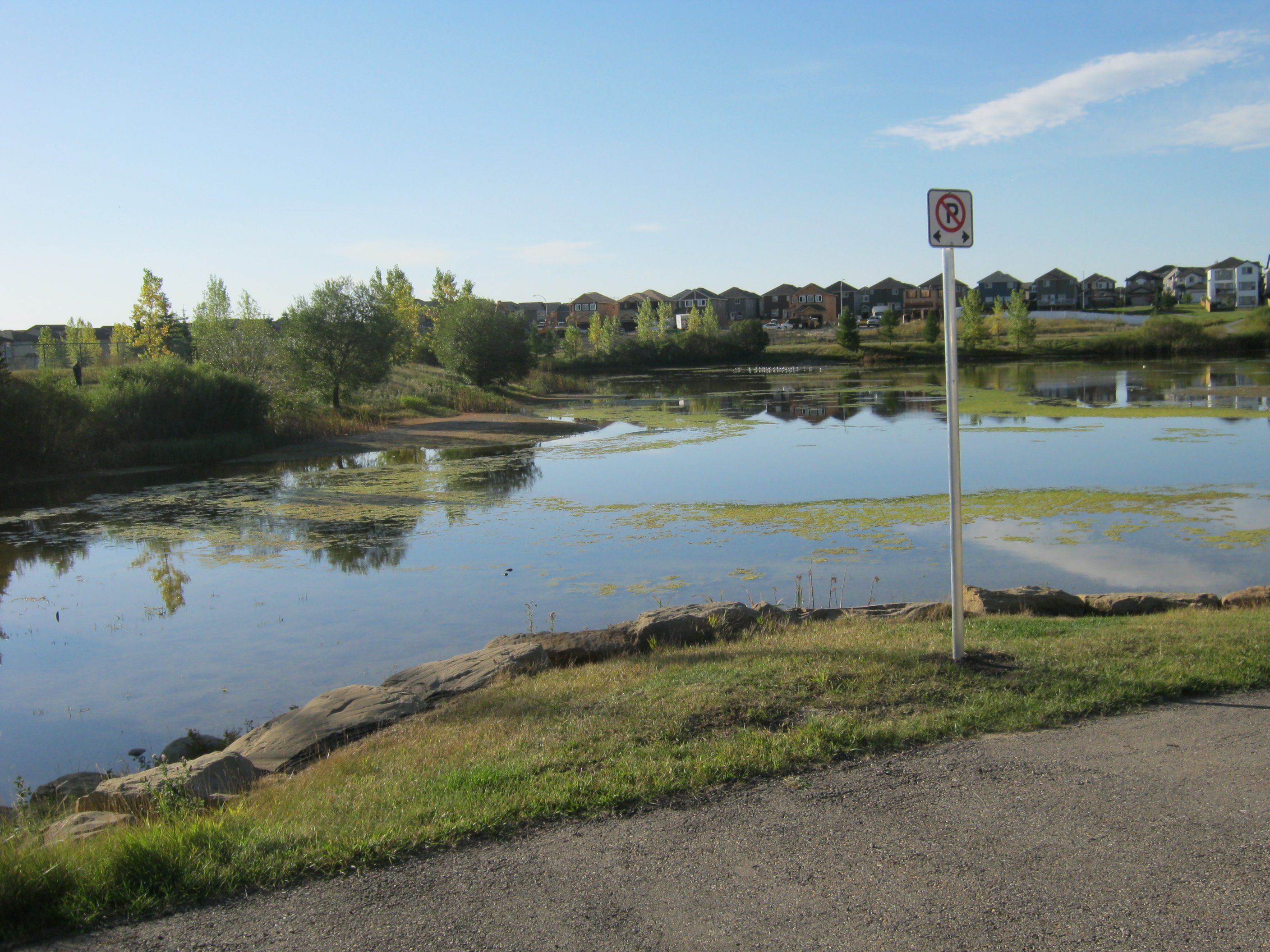 |
 |
|
Evergreen, Calgary, June 2014 (before) |
Evergreen, Calgary, August 2014 (after) |
What many people may not know is that specific consortiums of bacteria are used around the world to help treat wastewater as well. They address challenges including:
- Enhanced nitrification (see Figure 1)
- Biological oxygen demand (BOD) improvement – by taking care of this you make sure natural levels of oxygen in rivers or ocean / discharge outlets are preserved
- Odours (H2S)
- Sludge reduction – through using the right bacteria you can reduce biosolids, which are the organic matter recycled from sewage.
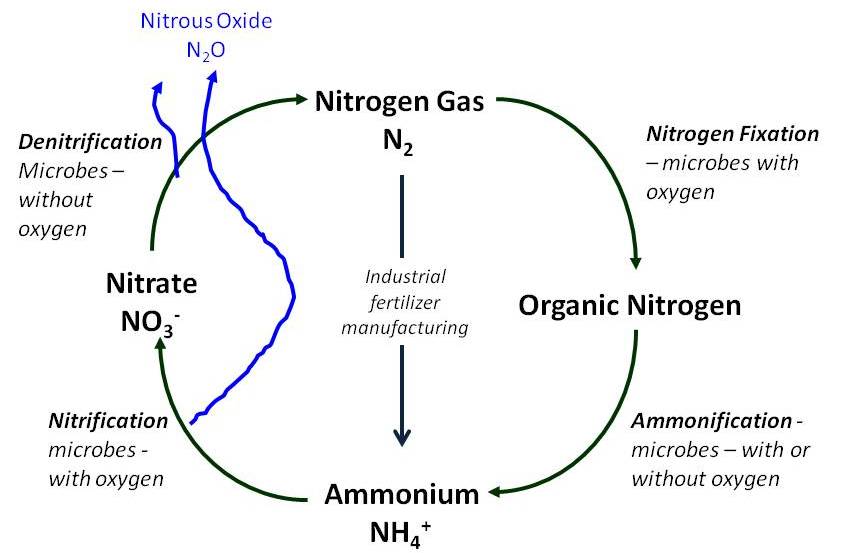 |
|
Figure 1: the nitrogen cycle |
Later in the treatment process, bacteria make enzymes, which digest sludge; however, enzymes are made primarily when the bacteria are starved. The bottom of a sewage lagoon is not an ideal environment for bacteria to make sludge-digesting enzymes.
In a lagoon where bacteria are not producing enzymes quickly enough, the sludge will build up. This is why bacteria that are safe, naturally occurring, and not genetically altered are ideal for sludge and grease digestion. It is also possible to produce huge quantities of nitrifying and sludge digesting bacteria.
Bacteria have a significant role to play in water treatment. In Raymond, Alberta, Advanced Water Technologies cultures super concentrated bacteria, which are used in a simple treatment plan and applied to optimize both anaerobic and aerobic processes to address effluent qualities.
It’s impressive how these little bugs can reduce capital expenditure by possibly avoiding plant expansion or upgrades, and contributes to the efficiency of wastewater treatment plants by up to 40%. Combined with their work on algae, you have a formidable ally in addressing some of our most prevalent water treatment challenges.
Click here to watch a new video stepping you through the Advanced Water Technologies process.
Joshua Day Chief is the President at Advanced Water Technologies (AWT), an Alberta-based, family operated, biotechnology company developing and producing bacterial formulations that enhance the recycling process of nutrients and waste for application in lakes/ponds, agriculture, aquaculture, wastewater treatment and environmental remediation.
From Latrine to Otohime: A blog worth reading on the toilet!
By Hana Mason
This Saturday November 19th is World Toilet Day. A day dedicated to education and waste management, initiated by the World Toilet Organization, World Toilet Day seeks a world in which everyone has access to clean, safe waste management and disposal systems [1].
Sometimes the forgotten sibling of water treatment, wastewater disposal and management has been an issue for humankind throughout history. So let’s take a trip back in time to see where we’ve come from and where we’re going with this critical piece of water management infrastructure!
In Ancient Egypt, in-home latrines filled with sand (much like a human litter-box) provided a private area for Egyptians to do their business. The Indus Valley civilization of c.2600-1900BC had an advanced network of sewers. The Romans used sewer systems to collect rainwater and sewage, and even had a sewer goddess, Cloacina [2].
The Roman sewer goddess Cloacina (no image copyright information available)
During the middle ages in Europe, hole-in-the-ground latrines made way for monasteries with complicated stone and wood lavatories over rivers and oceans, letting waste fall straight into the water. Furthermore, during the castle-building boom, chamber pots and latrines turned to garderobes – vertical shafts in castles which emptied into cesspools and moats. Garderobes were some of the first waste-disposal methods integrated into architecture in Europe.
Throughout this time, though particularly in the Middle Ages, poor waste disposal methods led to widespread illness such as the plague, typhus and cholera. Problems similar to this, mostly regarding waste contaminating drinking water, still affect a third of the world’s population [3].
Stepped garderobe shafts at Langley Castle, by Viollet-le-Duc
The move towards modern-day toilets began in the 1500s. Sir John Harrington invented the flushing lavatory and cistern in 1596. Up until then, the use of chamber pots, cesspits and earth closets were popular. In fact, they continued to be popular until 1775, when Alexander Cumming received a patent for the flush toilet, and 1778, when Joseph Brahman created a better design.
“Thomas Crapper” is often cited as the inventor of the flush toilet, but that has be proven a myth.
It’s easy to say, of course, that we are much better off in the way of toilets today, but we are missing out on one thing – many chamber pots and porcelain toilet bowls in the early days were lavishly decorated. The fuzzy toilet-seat covers of the 1970s and beyond don’t really measure up to the artful works of the 1500-1700s [3].
That’s not to say toilets and waste management haven’t inspired art. Artist Wim Delvoye has created a series of pieces titled Cloaca. The complicated and artfully designed machines have one unique, seemingly useless purpose – create excrement. Replicating the human digestive system, the machines take in food and pump out waste. 100% real waste, created artificially. The meaning and reason behind these creations are not always clear, but could certainly be a talking point for your Toilet Day conversations! [4]
Modern toilets range from your every-day bowls, to dual-flush, energy efficient toilets, and advanced Japanese “smart toilets”.
In Japan and other areas in Asia, squat toilets—essentially horizontal urinals—have been popular for most of history. Historically the same as European latrines but lacking seats, modern-day squat toilets have similar internal plumbing set-ups to western flush toilets. However, western-style toilets have gained some popularity, particularly in areas with heavy western influence.
High-tech “smart toilets”, which are called Washlets by Japanese locals, include such features as heated seats, bidet functions, and blow dryers. Tourists may be intimidated, but locals love them so much, they even include them in their homes.
Smart toilet with seat-side and wall-mounted control panels (bestofremodeling.com)
One considerable innovation in Japanese toilet-tech is the Otohime, which plays flushing noises while the toilets are in use. This seemingly bizarre item became necessary when the popular habit of continually flushing to gain privacy began to waste too much water. In Japan, use of the Otohime and similar music-playing toilet devices has helped save an estimated 20L of water each use [5].
In modern-day Europe, you’ll find coin-operated toilet booths in the street and public toilets requiring a fee to use.
Here in Alberta, self-cleaning public toilets rooms pepper our downtown landscapes, for instance you can find some along the river in downtown Calgary, near the Simmons building.
A pay-per-use public toilet in London, England
(“2010-10-15-09-33-35” by “zmtomako” is licensed under CC by 2.0)
Some more modern innovations in waste management are on their way to helping create healthy, clean and safe waste disposal globally. Mobile Toilets are cheap, portable toilets, often biodegradable bags which can be sealed. Composting Toilets and outhouses create fertilizer from human waste, providing a key ingredient for agriculture. Used not just in the developing world composting toilets are feasible options for everyone. Bio-energy Toilets turn sewage into clean water, electrical power and fertilizer. Solar Toilets are solar powered and break down waste for re-use as energy [6].
To encourage water conservation Alberta has used toilet rebate programs. Up until August 2016, the City of Calgary offered a rebate program for switching to dual-flush toilets, and municipalities such as Airdrie and Athabasca continue to do so. It’s worth checking out if your local municipality offers rebates on dual-flush toilets [7].
Toilet designs past, present and future aside; World Toilet Day helps us appreciate the role of sanitation and wastewater management around the world. Not a bad thing considering, on average, we spend three years of our life on a toilet…
Hana was a summer student with the Alberta WaterPortal Society in 2016. In her spare time she enjoys reading, writing, and spending time with friends. She is currently in Victoria, B.C, studying Writing at the University of Victoria.
Sources
[1] [http://worldtoilet.org/what-we-do/world-toilet-day/
[2]http://www.localhistories.org/toilets.html
[3] [http://www.smithsonianmag.com/history/turrets-toilets-partial-history-throne-room-180951788/
[4] [https://www.wimdelvoye.be/work/cloaca/
[5]https://en.wikipedia.org/wiki/Toilets_in_Japan
[6] [http://www.pbs.org/newshour/rundown/4-innovative-toilet-designs-to-talk-about-on-world-toilet-day/
When wildfires threaten our drinking water
By François-Nicolas Robinne
In May 2016, the Horse River fire in Fort McMurray burned approximately 600,000 ha and reminded us, with its many acres of boreal forest, Alberta can be a fire-prone region (Figure 1). The boreal forest ecosystem, due to its vegetation characteristics, is conducive to fire. If one feels a bit nerdy on a snowy Canadian weekend and wants to spent some time looking at satellite images provided by NASA, you would rapidly see there is always a fire burning somewhere in the world.
What is important to bear in mind is that, for better or for worse, vegetation fires are an essential part of landscape function and development. However, fire also impacts some ecosystem services (the benefits human communities can get from nature) which often translates into a myriad of issues.

Figure 1: The Athasbasca River valley after the Horse River fire, near Fort McMurray (Credit: X. Cai, University of Alberta, Sept. 2016)
Known impacts to ecosystem services
Two ecosystem services provided by healthy forests are filtration of precipitation water and erosion control, both of which are important to human communities[1].
The way a wildfire usually impacts surface freshwater supplies follows a general course. The combustion of above-ground vegetation and litter produces ash and can release heavy metals and nutrients previously tied up in the vegetation and soil (Figure 2).
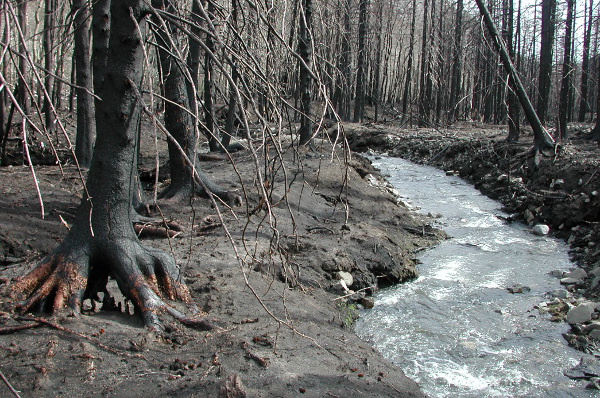
Figure 2: A creek after the Lost Creek fire, Alberta, 2003 (Credit U. Silins, University of Alberta, 2004)
Heat from combustion also alters soil structure decreasing soil stability and soil water-infiltration capacities. When rain falls the absence of vegetative cover allows water to wash over the ground surface as excess runoff. This runoff exerts a great erosive power on unprotected soils, carrying sediments, chemicals, debris, and ashes to the stream network (Figure 3).
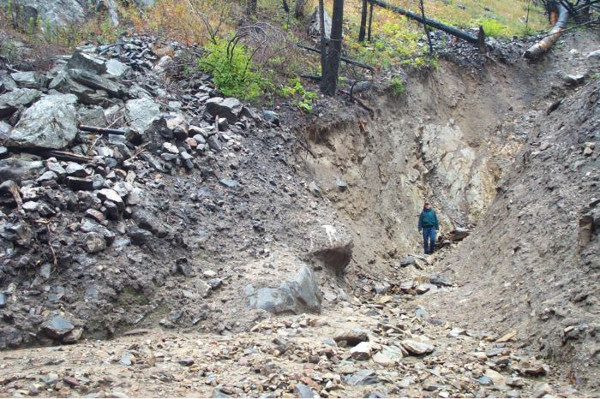
Figure 3: Burned hillslope that has been eroded down to bedrock near Sula, Montana.
All that sediment was moved off the hillslope and into the stream (Credit: Istituto di Ricerca per la Protezione Idrogeologica, 2016)
An increase in run-off, coupled with release of debris and nutrients, can alter water quantity and quality.
The degree to which fire affects water and soil is also a function of fire severity, the timing and intensity of post-fire rainfalls, and topography. As such, a severe wildfire in a steep terrain followed by a rainstorm would be the worst scenario in terms of post-fire hydrologic hazards.
More on this topic can be found in a reference report from the US Department of Agriculture[2].
Emerging research in post-fire hydrological hazards
The science of post-fire hydrology has been around for decades, mostly led by researchers from USA, Australia, South-Africa, Portugal, and Canada. Hundreds of publications have focused on the complexity and diversity of responses of small-to-large watersheds to flames in different environments. In some cases, results show changes in pollutant loads can reach more than a thousand times the pre-fire values, sometimes for several years after the blaze[3].
Nevertheless, the number of studies specifically dealing with post-fire hydrologic hazards and downstream risks to communities remains fairly low. Attention to this specific topic has only been growing for a decade or so: the notion of watershed-wildfire risk was further explored in 2013[4]. This was followed in 2016 by a general definition of the wildfire-water risk: the potential harmful effects of wildfire activity on water quality, quantity and seasonality; in proportions that can impair the freshwater supply to downstream human and natural communities[5].
It is usually assumed that the volume of water provided by tributaries and runoff is enough to dilute pollutants, limiting any harmful health or environmental effect. However, the actual vulnerability of the drinking-water supply after a wildfire will partly depend on the distance to the closest drinking-water treatment plant.
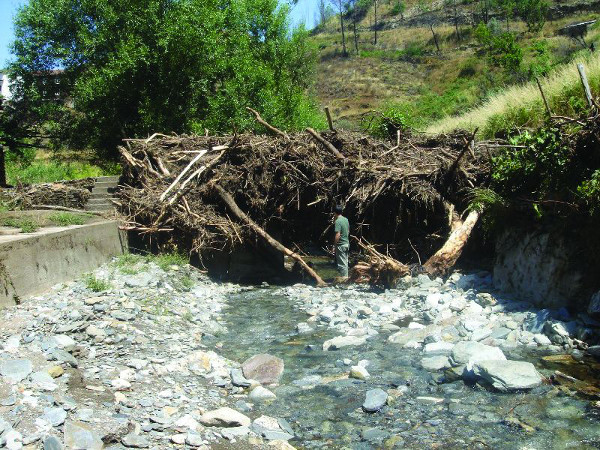
Figure 4: Wood accumulation following the wildfire at Sobral Magro, in the Pomares basin, Portugal, 2005 (Credit: L. Lourenço, Universidade de Coimbra, 2012)[7]
A 2014 report[6] lists potential water-related hazards a community might have to face after a wildfire, which may include the following hazards.
One concern is water turbidity, which refers to the load of solid particulates in the water, is a major concern for water-treatment plant filtering capacities. In addition, the amount of debris combined with unusually high water flow may damage water intakes and water-treatment infrastructures (Figure 4). The sediment load is also problematic as it gets deposited in human-made reservoirs in higher quantities than initially planned, which may reduce their life expectancy[8] (Figure 5).
Another concern is higher-than-normal concentrations of dissolved nutrients such as organic carbon, phosphorus, or nitrogen. Increased concentrations of those compounds increase the use of disinfectants that keep drinking water safe. This may temporarily raise treatment costs and concentrations of disinfection by-products (such as trihalomethanes) until the organics have been flushed from the watershed.
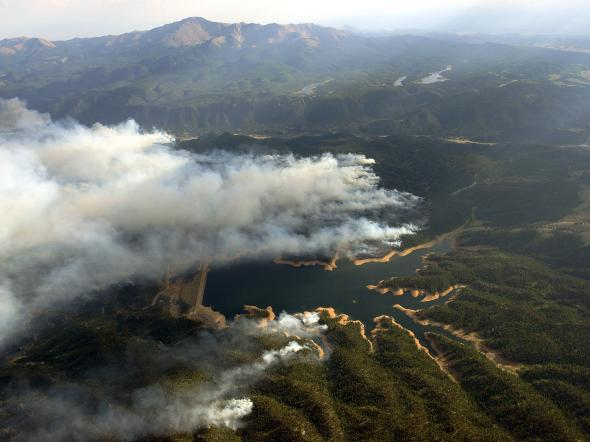
Figure 5: Rampart Reservoir during the Waldo Canyon fire in Colorado (Credit: John Wark, Reuters, 2012)
Several tools and methods exist to tackle post-fire hydrologic hazards; the best of which can be preventing wildfire from burning a watershed too often and/or too severely. When such a fire happens, the strategy usually consists of two main parts: identifying the most-likely upstream sources of post-fire pollutants using the capabilities offered by computer-assisted modeling and mapping, and intervening in burned areas with the deployment of post-fire treatments on the designated watershed hillslopes.
Different families of treatment exist including the application of a protective cover using mulch or helping vegetation recovery, the construction of erosion barriers (Figure 6), and the stabilization of river channels and roads[9].

Figure 6: A silt fence on a burned slope (Credit: New Mexico State Forestry, 2016)
The Alberta context
Generally, Alberta burns frequently and severely. In the period 2005-2014 almost 170,000 ha burned, on average, every year. In this context, learning to live with wildfires consequences is a reality and Alberta is leading the national effort to raise awareness about wildfire-induced risks to the water supply.
After the Lost Creek fire in 2003, many studies demonstrated changes in water chemistry potentially harmful for human health[10]. In 2012, a four year project funded by the Canadian Water Network enabled a team of researchers and managers to achieve a provincial scale study of the wildfire risk to the water supply. Since the Horse River fire in 2016, several research teams are gathering efforts to understand and limit the risk to the Fort McMurray water supply, which comes exclusively from the Athabasca River (Figure 7). This work includes using state-of-the-art technologies, with the hope new knowledge will help prevent further disturbances to a community in a high wildfire risk zone.
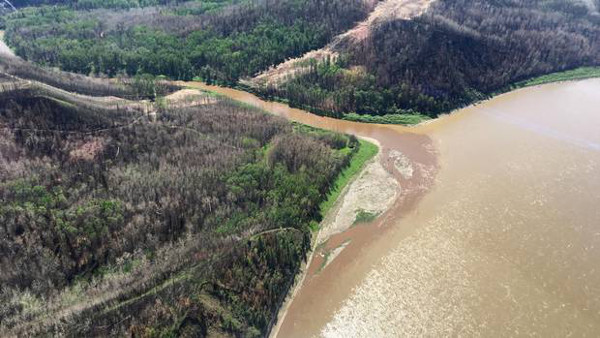
Figure 7: The mouth of the Horse River where it empties into the Athabasca River on June 10 after the first big rainfall event near Fort McMurray (Credit: The Globe And Mail, 2016)[11]
Although this post is focused on the surface drinking-water supply, post-fire hydrological hazards also affect other aspects of everyday life (e.g. recreation). Wildfire can affect vulnerable aquatic ecosystems by increasing turbidity, heavy metal and nutrient concentrations. Whenever water resources are threatened, the functioning of all living ecosystems can be disturbed.
In an era of global changes and climate extremes, humans are playing an ever-increasing role in wildfire occurrence and freshwater resource availability. Therefore, the nexus between wildfires, water, and societies — human and natural — deserves a better understanding[12] and future wildfire risks to the water supply in densely populated water basins need to be identified and properly managed[13].
Francois is currently a Ph.D Candidate, Western Partnership for Wildland Fire Science, at the University of Alberta. He kindly offered to author this blog following the release of How wildfires impact a watershed.
References
1. Millenium Ecosystem Assessment. Ecosystems and human well-being: Synthesis. World Resources Institute (Island Press, 2005). doi:10.1196/annals.1439.003
2. USDA. Wildland Fire in Ecosystems, Effects of Fire on Soil and Water. 4, (2005).
3. Shakesby, R. a. & Doerr, S. H. Wildfire as a hydrological and geomorphological agent. Earth-Science Rev. 74, 269–307 (2006).
4. Thompson, M. P. et al. Assessing Watershed-Wildfire Risks on National Forest System Lands in the Rocky Mountain Region of the United States. Water 5, 945–971 (2013).
5. Robinne, F. et al. A Global Index for Mapping the Exposure of Water Resources to Wildfire. Forests 7, 22 (2016).
6. Emelko, M. B. & Ho Sham, C. Wildfire Impacts on Water Supplies and the Potential for Mitigation : Workshop Report. (2014).
7. Lourenço, L., Nunes, A., Bento-Gonçalves, A. & Vieira, A. Soil Erosion After Wildfires in Portugal : What Happens When Heavy Rainfall Events Occur ? Res. Soil Eros. 1–24 (2012). doi:DOI: 10.5772/50447
8. Moody, J. a. & Martin, D. a. Wildfire impacts on reservoir sedimentation in the western United States. Proc. Ninth Int. Symp. River Sediment. 1095–1102 (2004).
9. New Mexico State Forestry. After Wildfires – a guide for New-Mexico communities. (2016). at <http://afterwildfirenm.org/post-fire-treatments>
10. Emelko, M. B., Silins, U., Bladon, K. D. & Stone, M. Implications of land disturbance on drinking water treatability in a changing climate: Demonstrating the need for ‘source water supply and protection’ strategies. Water Res. 45, 461–472 (2011).
11. Cecco, L. Fire and water. The Globe and Mail (2016). at <http://www.theglobeandmail.com/news/alberta/wildfires-have-major-impact-on-waterquality/article30512613/>
12. Martin, D. A. At the Nexus of Fire, Water and Society. Philos. Trans. R. Soc. Lond. B. Biol. Sci. this issue (2016).
13. Bladon, K. D., Emelko, M. B., Silins, U. & Stone, M. Wildfire and the Future of Water Supply. Environ. Sci. Technol. 48, 8936–8943 (2014).
Challenges and Solutions in Acquiring Water for Housing Development
By Lorraine Nicol, Ph.D
A facet of water management which greatly interests me as a researcher is the challenges involved in satisfying competing demands for water, especially given the province’s fixed licensed water allocation framework. To some extent, my research has become more and more finely focused on one singular question: how effectively are users navigating the water market in water basins that are closed to new licensed water allocation applications?
My most recent project focused on housing developers in the Calgary region. It was funded by the Alberta Real Estate Foundation. The research was prompted by an earlier, 2015, study of water management within Rocky View County. In that study (entitled ‘Challenges and Potential Adaptation Strategies of Rural Water Co-ops: An Alberta Case Study’) I found preliminary evidence that housing developers in Rocky View were very pessimistic about the future of their industry, given the challenges they face in acquiring licensed water allocations for their developments.
By Rishichhibber (Own work)
[CC BY-SA 3.0 (http://creativecommons.org/licenses/by-sa/3.0)], via Wikimedia Commons
The more recent study explored water challenges in more depth by expanding the number of municipalities to include Rocky View County, M.D. Foothills, and the Town of Okotoks. The study involved interviews with 15 developers working in these municipalities.
The study considered four main lines of inquiry:
(a) developers’ views of water challenges;
(b) the nature and source of the problem;
(c) the consequence of water challenges; and
(d) solutions.
An additional dimension of the study involved a preliminary assessment of the potential impact a decline in housing construction could have on the real estate sector.
The study’s finding confirmed my earlier suspicion that challenges for developers are prevalent. In addition this study found that, for many developers: acquiring water is their main issue; housing development is now, or will be in the future, negatively affected; water has become politicized; and housing prices are absorbing the top dollar developers are paying for water licenses.
The study specifically found:
- 100% of the developers interviewed believe there are challenges in acquiring licensed water allocations for housing development in the three municipalities under study;
- 73% stated acquiring a licensed water allocation is the ‘primary issue’ for developers;
- 60% of interviewees believe water management in the region is political, to the detriment of the housing industry;
- Another 53% believe the source of the problem also relates to government processes;
- 87% of developers believe water challenges are having a negative effect on the industry, either now or in the future;
- Two-thirds of developers say the cost of acquiring water licenses increases the price of homes.
Photo: che at Czech Wikipedia Adjustment: Li-sung at Czech Wikipedia (Own work)
[CC BY-SA 2.5 (http://creativecommons.org/licenses/by-sa/2.5)], via Wikimedia Commons
The solution to water challenges in the region is easy to identify but difficult to implement. All developers believe a solution lies in working together as a region under an umbrella organization. However, in studying regionalism for my Ph.D dissertation (the Calgary Regional Partnership in particular), history and experience tell us that some regional models work better than others, depending on the dynamics in the region.
Developers believe a regional framework would not only help re-allocate water but also alleviate the high cost of water and wastewater treatment facilities if the cost of such facilities could be shared. However, developers are also aware of the confrontational environment amongst some municipalities in the Calgary region and are therefore also cognizant of how difficult a workable regional model is to craft.
Dr. Lorraine Nicol is a Research Associate in the Economics Department, University of Lethbridge. Her expertise is in water and city-regionalism, participatory processes in water management, Alberta water issues and policy, and water markets. To see a list of her publications click here.
Finding resonance: Alberta’s youth and water literacy in the age of technology
By Hana Mason
I am part of the ‘tech generation’ – born and bred at the turning point of computer technology. I remember the changes—from playing reading games on my parent’s huge Microsoft computer to getting my first iPod Nano, from flip phones to larger-than-life smartphones. There seems to be a belief that because my generation grew up with technology, we are tied eternally and unconditionally to our phones. If you ask any of us, we’ll most likely deny such allegations, but I wonder what the real answer is. Have we abandoned our exploratory roots of our surrounding environment? Or have our relationships with our environment changed with the development of technology?
I will be the first to admit many of my day-to-day choices revolve around whether or not it’ll make a good Instagram! But I also believe that even if some part of me is drawn to a hike just for the photo of the view, some other, deeper part of me is drawn to it for the view itself—for the experience. You see, my peers and I still experience a strong connection to nature. From camping and visiting family cabins to summer camps and visits to community lakes, we’re never so tied to the world of the internet that we don’t have a call to the wild.
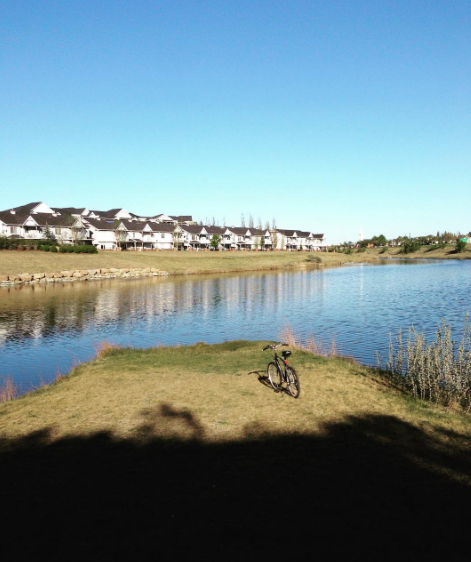
Image courtesy of myself (my favourite place to ride my bike!)
In considering my time on and off the internet, I realize—despite my avid belief that my generation’s obsession isn’t entirely encompassing—I haven’t had many discussions with my peers about water-related, or even simply environment-related, issues.
The last time I learned anything new about water conservation was my last field trip to a wetland, which was probably six or seven years ago. So, I decided to ask my friends about water.
What are your connections to water? What do you know about water issues? What does water mean to you? Before I reached out to my friends, I asked myself these questions. I’m going to be completely honest – I know almost nothing about water issues. But I do have a connection to my environment. My personal water story has been mainly to do with summer camp. I learned to canoe at camp. I learned teamwork, determination, and an appreciation for natural rivers and lakes. Besides that, spending endless summer hours by the lake have kept me always looking from my screen back to nature, whether it is in search of the perfect profile picture or a way to satisfy my nostalgia.
As for my friends and peers’ responses to my water questions, I received varied, but passionate, results.
Emily F. grew up on the east coast, but once she moved west, she found a love of kayaking and canoeing. Exploring the Alberta wilderness, whether it be paddling or hiking, has become a huge part of her life. “It’s a really nice break,” she tells me, “I’m not really thinking about the things I’m supposed to be worrying about here.”

Image courtesy of Emily F. (from one of her many adventures)
The stress of school, work and social life can be overwhelming, particularly in our constantly connected world. That being said, Emily finds the social media platforms she’s a part of let her connect with other hiking and paddling enthusiasts. This makes it easier to find trails and rivers to visit. Despite this however, she finds herself uninformed about water and environmental issues and literacy. “I’m not oblivious, but I feel like there’s information missing” she says, rating her water literacy a six out of ten.
Kate S. also grew up around water. She spent most of her early life in Toronto, and the vast difference between the concrete jungle and the spread-out landscape of Calgary, where her backyard is a community lake, has come to be very important to her.
“We’ve been so blessed, not everywhere is like this,” she tells me. However, Kate has mixed feelings towards the affects of social media on her experience with the environment. She tells me she finds people to be too connected and that certain technologies allow people to never leave their houses. On the other hand, she finds the Instagram trends of fun hikes and great views create an environment where we are socially rewarded for going outside.
I ask her what she knows about water-related issues. In a similar response to Emily and myself, the answer is very little. It seems my generation knows the basics for water conservation – don’t let the water run when you’re brushing your teeth, take shorter showers – but we don’t really comprehend the scope.
“Because I don’t really see the first hand affects,” Kate explains, “it doesn’t really resonate.” This seems to be a popular explanation for our relative apathy – we have such easy, thoughtless access to clean water here in Alberta that we can’t even imagine what life would be like if it became unavailable. We view water scarcity as a far-away thing for developing countries, not for ourselves. Why would it resonate?
Much like my other two interviewees, Drew R. grew up loving water and hanging out in nature. He loves swimming and boasts, “I could swim before I could walk!” But after a traumatic experience last year and a growing love for social media, Drew spends considerably less time outdoors, and much less time swimming. Despite this, he explains that technology has allowed him to learn a lot more about bodies of water far away from where he lives. He has entertained the thought, “Since I don’t live anywhere near an ocean it’s not really the kind of thing I need to worry about”, but he rates his water literacy a seven out of ten, and he wants to learn about pollution, water filtration, and how to “help and do my part to keep our water safe and clean.”
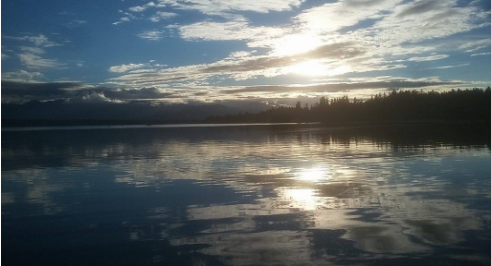
Image courtesy of Drew R. (“my favourite” he calls it)
I set out to prove something with this blog—that my generation isn’t entirely tied to our phones, and that we have a deep rooted connection to our environments. With so many different perspectives and views, the only thing I could really prove was my generation has opinions. Like other generations, everyone I talked to had something to say.
At the end of it all, I think I can sincerely say my generation still cares about our environment, and we’re trying our best to use the advanced technology we’ve been given to our advantage. With the evolution of technology, our relationships with our environment, and the issues pertaining to it, will change too. The challenge is finding a way to make the pressing issues matter to us. We already care, now we must find that deeper resonance.
Hana is a summer student with the Alberta WaterPortal Society. In her spare time she enjoys reading, writing, and spending time with friends. She will be moving to Victoria, B.C. to study Writing at the University of Victoria in September 2016.


